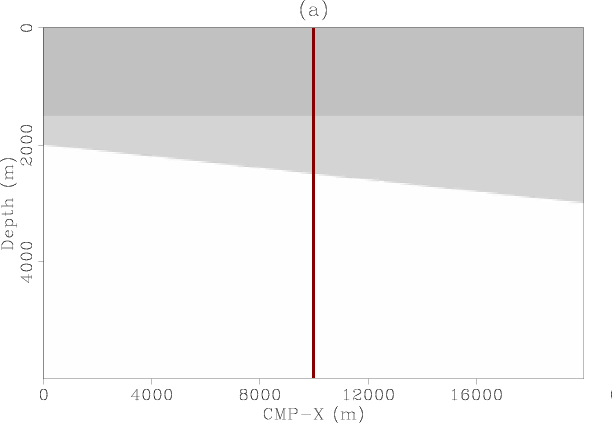|
|
|
|

|
|---|
|
model-vel
Figure 5. 3-D velocity model. Panel (a) is the inline section taken at CMP-X=2000 m and panel (b) is the crossline section taken at CMP-Y=10000 m. The water-bottom dips in the crossline direction only. The reflector dips gently (3 deg) in the inline direction as well. |
|
|
The acquisition geometry consists of 10 receiver lines, each with 240 receivers spaced 25 m, with the first receiver at an inline offset of 100 m from the source. The maximum inline offset is therefore 6075 m. The receiver line separation is 100 m and the source is flip-flop with the two sources separated 50 m in the crossline direction and centered between the two middle streamers. There are a total of 6 sail lines with each sail line separated from the next by a crossline distance of 450 m. With this arrangement, the crossline fold is just one and the fold in the inline direction is 60. Figure 6 shows a schematic of two adjacent sail lines illustrating that there is no overlap between the CMP coverage of each sail line. Figure 7 shows the receiver map, the source map, the azimuth-offset distribution and the fold map, all typical of a dual source acquisition.
|
sketch2
Figure 6. Schematic of fold coverage of two adjacent sail lines. |

|
|---|---|
|
|

|
|---|
|
attributes
Figure 7. Top left: receiver map. Top right: source map. Bottom left: azimuth-offset distribution. Bottom right: fold map. |
|
|
Figure 8 shows a typical common source record with the 10 receiver lines plotted side-by-side. There are four reflections: the water-bottom primary, the deeper reflector primary, the water-bottom multiple and the peg-leg multiple between the water-bottom and the deeper reflection. Notice the change in polarity of the multiples compared to the primaries. Figure 9 shows a close up of the wavelet and the wavelet spectrum which shows that the wavelet has a DC component.

|
|---|
|
shot
Figure 8. A typical ``shot'' gather showing the 10 receiver lines. Notice the polarity inversion of the multiples. |
|
|

|
|---|
|
spectrum
Figure 9. Close up of the seismic wavelet (a) and its frequency spectrum (b). Notice the uncharacteristic presence of low frequencies usually absent in field data. |
|
|
|
|
|
|